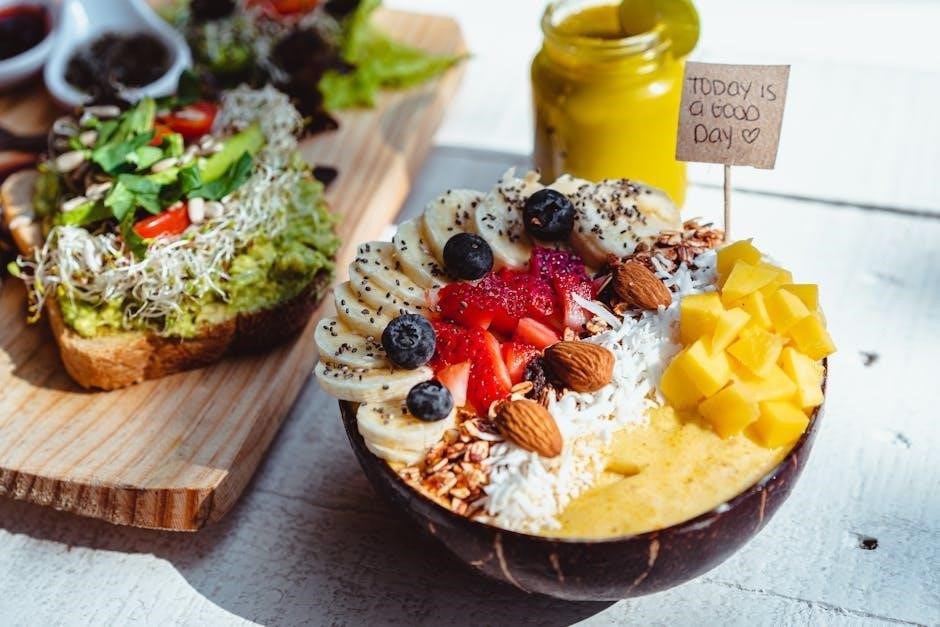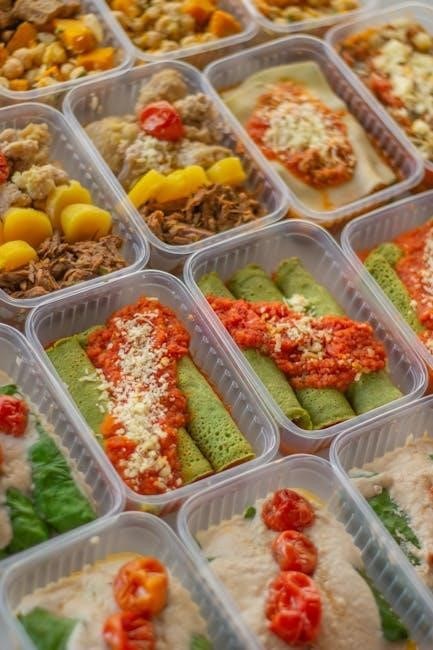Start your journey toward optimal health with our 7-day alkaline meal plan. Emphasizing fresh fruits‚ vegetables‚ nuts‚ and seeds‚ this structured guide promotes pH balance and vitality through delicious‚ nutrient-rich recipes designed to boost energy and support well-being.
Understanding the Alkaline Diet
The alkaline diet focuses on consuming alkaline-forming foods to balance the body’s pH levels‚ promoting overall health and preventing chronic diseases. It emphasizes fresh vegetables‚ fruits‚ nuts‚ seeds‚ and legumes‚ while reducing acidic foods like meat‚ dairy‚ and processed items. The goal is to maintain a slightly alkaline blood pH‚ believed to support immune function and reduce inflammation. While the diet doesn’t require eliminating acidic foods entirely‚ it encourages a balance where 60% of meals are alkaline-based. By focusing on nutrient-rich‚ plant-based options‚ the alkaline diet aims to enhance vitality and protect against illness‚ offering a sustainable approach to long-term wellness.

Benefits of Following an Alkaline Diet

Following an alkaline diet offers numerous health benefits‚ including improved digestion‚ enhanced energy levels‚ and better nutrient absorption. It promotes a balanced pH level in the body‚ reducing acidity-related discomforts like bloating and indigestion. By focusing on alkaline-forming foods‚ the diet supports weight management‚ strengthens bone health‚ and may reduce the risk of chronic diseases such as osteoporosis and diabetes. Additionally‚ it encourages healthier skin and hair and can improve mental clarity. Many people report feeling more energized and experiencing fewer cravings for unhealthy foods. Overall‚ the alkaline diet is a holistic approach to improving overall well-being by fostering a nutritious and balanced lifestyle.

Foods to Include in Your 7-Day Alkaline Meal Plan
The alkaline diet focuses on fresh fruits‚ vegetables‚ nuts‚ seeds‚ healthy fats‚ legumes‚ and whole grains to promote pH balance and overall well-being naturally.
Alkaline-Forming Foods: Fruits and Vegetables
Fresh fruits and vegetables are the cornerstone of an alkaline diet‚ providing essential vitamins‚ minerals‚ and antioxidants. Alkaline-forming options include leafy greens like spinach‚ kale‚ and Swiss chard‚ as well as citrus fruits like lemons and oranges. Other alkaline-rich choices are cucumbers‚ bell peppers‚ avocados‚ and tomatoes. Berries such as strawberries‚ blueberries‚ and raspberries are also excellent additions. These foods help neutralize acidity in the body‚ promoting a balanced pH level. Incorporating a variety of colorful fruits and vegetables ensures a broad spectrum of nutrients and supports overall health. Aim to include at least 5 servings daily‚ either raw‚ juiced‚ or lightly cooked to preserve their alkaline properties.
Nuts‚ Seeds‚ and Healthy Fats
Nuts‚ seeds‚ and healthy fats are essential for an alkaline diet‚ offering omega-3 fatty acids and other nutrients. Almonds‚ walnuts‚ chia seeds‚ flaxseeds‚ and hemp seeds are excellent alkaline-forming choices. Avocados and olive oil are also beneficial‚ providing healthy fats that support heart health and digestion. These foods help reduce inflammation and promote a balanced pH level. Incorporate them as snacks or add them to meals for texture and flavor. Opt for raw‚ unsalted‚ and unroasted options to maximize their alkaline properties. A small handful of nuts or seeds daily‚ along with a tablespoon of healthy fats‚ can enhance your meal plan’s nutritional value and keep you satisfied.
Legumes and Whole Grains
Legumes and whole grains are integral to the alkaline diet‚ offering rich sources of fiber‚ vitamins‚ and minerals. Legumes like lentils‚ chickpeas‚ and black beans are alkaline-forming and high in protein‚ making them ideal for plant-based meals. Whole grains such as quinoa‚ brown rice‚ and oats provide sustained energy and support digestive health. These foods are also rich in antioxidants and help maintain a balanced pH level. Incorporate them into salads‚ soups‚ or as sides to diversify your meals. Pairing legumes with whole grains creates complete protein profiles‚ ensuring nutritional completeness. Opt for unprocessed‚ organic options to maximize their alkaline benefits and avoid refined or packaged versions that may disrupt pH balance.
Foods to Avoid on the Alkaline Diet
Foods to avoid include meat‚ dairy‚ processed items‚ and refined sugars‚ as they promote acidity and can disrupt the body’s pH balance‚ leading to inflammation and health issues.
Acidic Foods: Meat‚ Dairy‚ and Processed Items
Meat‚ dairy‚ and processed foods are highly acidic and should be minimized or avoided on the alkaline diet. Red meat‚ poultry‚ and fish contribute to acidity due to their high sulfur and phosphorus content. Dairy products‚ such as milk‚ cheese‚ and yogurt‚ are also acid-forming and can be difficult to digest. Processed items‚ including packaged snacks‚ sugary drinks‚ and refined grains‚ are detrimental to pH balance. These foods can lead to chronic inflammation‚ digestive issues‚ and energy crashes. Limiting or eliminating acidic foods helps reduce the body’s acidic load‚ promoting a more alkaline environment and supporting overall health. Focus on replacing these with alkaline-forming foods to maximize the benefits of the 7-day meal plan and improve long-term well-being.
Reducing Sugar and Refined Carbohydrates

Reducing sugar and refined carbohydrates is crucial for maintaining an alkaline environment in the body. Sugary drinks‚ processed snacks‚ and sweetened beverages are primary sources of added sugars that should be avoided. Hidden sugars in foods like baked goods and condiments also contribute to acidity. Opting for natural sugars from fruits‚ which come with fiber and nutrients‚ is preferable. Refined carbohydrates‚ such as white bread and pasta‚ should be replaced with whole grains like quinoa and brown rice‚ which are more alkaline-forming. Planning meals and snacks ahead of time‚ focusing on whole foods‚ and being mindful of portion sizes can help minimize sugar and carb intake. Keeping a food diary can aid in tracking progress and identifying areas for improvement‚ ensuring a balanced approach to reducing these acidic-forming foods for better overall health and pH balance.

Creating Your 7-Day Alkaline Meal Plan
Plan balanced meals with alkaline-forming foods‚ ensuring variety and nutrient-dense options. Focus on fruits‚ vegetables‚ nuts‚ seeds‚ legumes‚ and whole grains. Incorporate healthy fats and hydration sources like water and herbal teas. Consider meal prepping to stay organized and avoid last-minute acidic choices. Review and adjust based on dietary preferences and ingredient availability to maintain consistency and enjoyability throughout the week.
Structuring Meals for Optimal pH Balance
Start each day with an alkaline-rich breakfast‚ such as fresh fruits or green smoothies‚ to set a balanced tone. Pair alkaline-forming foods like spinach‚ kale‚ or bell peppers with lean proteins or healthy fats at lunch. For dinner‚ incorporate alkaline vegetables like broccoli or asparagus alongside whole grains like quinoa or brown rice. Snacks should include nuts‚ seeds‚ or fresh fruit to maintain pH balance. Hydration is key—drink water with lemon or cucumber slices to enhance alkalinity. Aim for a ratio of 70-80% alkaline-forming foods in each meal to support overall health. Avoid mixing acidic and alkaline foods in the same meal to prevent digestive imbalance and maximize nutrient absorption.
Meal Prepping and Grocery Shopping Tips
Plan your meals for the week ahead to ensure consistency and reduce food waste. Create a grocery list focusing on fresh‚ seasonal fruits and vegetables‚ nuts‚ seeds‚ and whole grains. Dedicate time on weekends for meal prepping—chop vegetables‚ cook proteins‚ and portion meals in airtight containers. Shop for alkaline staples like lemons‚ spinach‚ and avocados‚ and stock up on healthy fats such as olive oil and coconut oil. Store prepped meals in glass containers to maintain freshness and avoid chemical leaching. Freeze items like berries or leafy greens for later use in smoothies or salads. This structured approach simplifies adherence to the alkaline diet and saves time during busy weekdays.

Day-by-Day Meal Plan Overview
The 7-day plan offers a structured approach‚ introducing alkaline foods gradually. Each day focuses on balanced meals‚ ensuring variety and nutrient-rich options. Start with foundational recipes‚ then explore diverse flavors while staying hydrated and mindful of portion sizes.
Begin with simple‚ nutrient-dense meals to ease into the alkaline diet. Breakfasts include green smoothies or chia pudding‚ while lunches focus on fresh salads with alkaline-rich leafy greens. Dinners feature vegetable stir-fries or roasted dishes with herbs. Snacks like fresh fruits or trail mixes with almonds and seeds are encouraged. These meals are designed to detoxify and reset your system. Hydration is key‚ so drink plenty of water and consider adding lemon slices for extra alkalinity. Portion sizes are balanced to prevent overeating. This phase emphasizes whole‚ unprocessed foods to create a clean foundation for the week ahead. Keep meals colorful and varied to ensure a broad range of nutrients.
Day 4-6: Exploring New Recipes
By Day 4‚ you’ll feel more comfortable with alkaline foods‚ allowing you to experiment with new recipes. Incorporate more variety by adding tofu‚ tempeh‚ or seitan for plant-based protein. Try quinoa or brown rice bowls with roasted vegetables and fresh herbs. Salads can be elevated with creative dressings made from olive oil‚ apple cider vinegar‚ or tahini. Soups like alkaline-friendly vegetable broth or lentil soup are great for lunch or dinner. Introduce new flavors with spices like turmeric‚ cumin‚ and paprika. Meal prepping becomes easier as you learn to combine ingredients creatively. Snacks can include veggie sticks with hummus or energy balls made from dates and nuts. This phase encourages experimentation while maintaining the diet’s core principles.
Day 7: Final Adjustments and Reflection
On Day 7‚ focus on fine-tuning your alkaline diet based on how your body has responded. Reflect on your energy levels‚ digestion‚ and overall well-being. Adjust portion sizes or recipe ingredients if needed‚ ensuring you’re meeting your nutritional needs. Hydration remains key‚ so drink plenty of water throughout the day. Celebrate your progress and acknowledge any challenges overcome. Use this day to plan for the future‚ such as incorporating new alkaline recipes into your long-term routine. Reflect on what worked best for you and what changes you’d like to maintain. This final day is about reinforcing healthy habits and setting a positive mindset for continued success;

Tips for Sticking to the Alkaline Diet
Plan meals‚ keep it simple‚ and stay hydrated. Incorporate alkaline snacks and practice mindful eating. Track progress and stay committed to your health goals daily.
Snacking Smart with Alkaline Foods

Snacking smart on an alkaline diet involves choosing nutrient-dense‚ alkaline-forming foods. Opt for fresh fruits like apples‚ bananas‚ or berries‚ which are naturally alkaline and rich in vitamins. Veggie sticks such as cucumbers‚ carrots‚ or bell peppers paired with hummus make for a satisfying and healthy snack. Nuts and seeds like almonds‚ pumpkin seeds‚ or chia seeds are excellent choices‚ providing healthy fats and minerals. For convenience‚ keep a stash of trail mix made with alkaline nuts and seeds. Herbs like parsley or cilantro can be added to snacks for extra alkalinity. Avoid processed or sugary snacks‚ as they promote acidity. Staying hydrated with water or herbal teas between meals also supports an alkaline environment. Plan snacks in advance to prevent cravings for acidic foods and maintain your dietary goals. Incorporate these options into your 7-day plan for consistent energy and pH balance.

Staying Hydrated and Mindful Eating
Completing the 7-day alkaline meal plan marks a great achievement. Use the knowledge and benefits gained‚ such as improved energy and digestion‚ to continue a healthier lifestyle;
Final Thoughts on the 7-Day Plan
Completing the 7-day alkaline meal plan is a significant accomplishment. This structured approach provides a clear roadmap to resetting eating habits and embracing a more balanced lifestyle. By focusing on nutrient-rich‚ alkaline-forming foods‚ individuals can experience improved energy levels‚ better digestion‚ and enhanced overall well-being. The variety of recipes and meal ideas offered in the plan ensures diversity and satisfaction‚ making it easier to adhere to the diet. Remember‚ consistency is key‚ and even small adjustments can lead to long-term benefits. Use this week as a foundation to continue exploring the alkaline lifestyle and celebrate the progress made toward a healthier‚ more vibrant you.
Next Steps for Long-Term Health
After completing the 7-day alkaline meal plan‚ the focus shifts to maintaining and building on the progress. Gradually incorporate more alkaline-forming foods into your diet while continuing to minimize acidic options. Experiment with new recipes and flavors to keep meals exciting and prevent boredom. Consistency is crucial‚ so aim to make alkaline eating a long-term lifestyle choice rather than a short-term fix. Regularly monitor how your body responds and adjust accordingly. Setting realistic goals and celebrating small victories will help sustain motivation. By committing to this balanced approach‚ you can enjoy lasting benefits such as improved energy‚ better digestion‚ and overall wellness. The alkaline diet is not just a meal plan—it’s a pathway to a healthier‚ more vibrant life.
